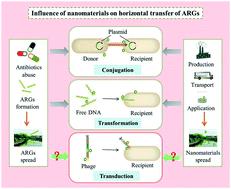当前位置:
X-MOL 学术
›
Environ. Sci.: Nano
›
论文详情
Our official English website, www.x-mol.net, welcomes your
feedback! (Note: you will need to create a separate account there.)
Impact of nano-TiO2 on horizontal transfer of resistance genes mediated by filamentous phage transduction
Environmental Science: Nano ( IF 5.8 ) Pub Date : 2020-02-25 , DOI: 10.1039/c9en01279f Xue Han 1, 2, 3, 4, 5 , Peng Lv 4, 5, 6, 7 , Lu-Guang Wang 8, 9, 10, 11 , Fei Long 8, 9, 10, 11 , Xiao-Lin Ma 4, 5, 6, 7 , Chang Liu 1, 2, 3, 4 , Yu-Jie Feng 4, 12, 13, 14 , Ming-Feng Yang 4, 5, 6, 7 , Xiang Xiao 1, 2, 3, 4, 5
Environmental Science: Nano ( IF 5.8 ) Pub Date : 2020-02-25 , DOI: 10.1039/c9en01279f Xue Han 1, 2, 3, 4, 5 , Peng Lv 4, 5, 6, 7 , Lu-Guang Wang 8, 9, 10, 11 , Fei Long 8, 9, 10, 11 , Xiao-Lin Ma 4, 5, 6, 7 , Chang Liu 1, 2, 3, 4 , Yu-Jie Feng 4, 12, 13, 14 , Ming-Feng Yang 4, 5, 6, 7 , Xiang Xiao 1, 2, 3, 4, 5
Affiliation

|
The spread of antibiotic resistance genes (ARGs) in the environment has aroused growing concern for human health and ecological safety. Recent studies have confirmed that engineered nanomaterials can increase the environmental risk of ARG dissemination mediated by conjugation and transformation. However, whether nanomaterials can mediate the transductive transfer of ARGs by phage infection has not been reported. In this work, the effect of nano-TiO2 on the horizontal transfer of ARGs to E. coli TG1 through transduction by constructed phage gM13 was investigated. Our results showed that nano-TiO2 concentration, particle size, mating time and the ratio of gM13/TG1 could influence the transductive transfer of ARGs. Further studies revealed that nano-TiO2 could promote bacteriophage attachment on cell surfaces, which contributed to gM13 infection. Meanwhile, increasing membrane permeability induced by nano-TiO2 could alleviate transmembrane resistance, which facilitated the infectious entry of phage gM13 into periplasmic space. The expressions of pilus-related genes were improved when E. coli TG1 was exposed to nano-TiO2. Thus, this work is beneficial for gaining a better understanding about the multiple environmental effects of increasingly released nanomaterials and is useful for the control of ARG dissemination in the environment.
中文翻译:

纳米TiO2对丝状噬菌体转导介导的抗性基因水平转移的影响
抗生素抗性基因(ARG)在环境中的传播引起了人们对人类健康和生态安全的日益关注。最近的研究证实,工程纳米材料可以增加通过共轭和转化介导的ARG传播的环境风险。然而,尚未报道纳米材料是否能通过噬菌体感染介导ARGs的转导转移。在这项工作中,研究了纳米TiO 2通过构建的噬菌体gM13的转导对ARGs水平转移至大肠杆菌TG1的影响。我们的结果表明,纳米TiO 2的浓度,粒径,交配时间和gM13 / TG1的比例可能会影响ARGs的转导传递。进一步的研究表明,纳米TiO2可以促进噬菌体在细胞表面的附着,从而导致gM13感染。同时,纳米TiO 2诱导的膜通透性增加可以减轻跨膜抗性,从而促进噬菌体gM13的感染进入周质空间。当大肠杆菌TG1暴露于纳米TiO 2时,菌毛相关基因的表达得到改善。因此,这项工作有益于更好地了解日益释放的纳米材料对多种环境的影响,并有助于控制ARG在环境中的传播。
更新日期:2020-02-25
中文翻译:

纳米TiO2对丝状噬菌体转导介导的抗性基因水平转移的影响
抗生素抗性基因(ARG)在环境中的传播引起了人们对人类健康和生态安全的日益关注。最近的研究证实,工程纳米材料可以增加通过共轭和转化介导的ARG传播的环境风险。然而,尚未报道纳米材料是否能通过噬菌体感染介导ARGs的转导转移。在这项工作中,研究了纳米TiO 2通过构建的噬菌体gM13的转导对ARGs水平转移至大肠杆菌TG1的影响。我们的结果表明,纳米TiO 2的浓度,粒径,交配时间和gM13 / TG1的比例可能会影响ARGs的转导传递。进一步的研究表明,纳米TiO2可以促进噬菌体在细胞表面的附着,从而导致gM13感染。同时,纳米TiO 2诱导的膜通透性增加可以减轻跨膜抗性,从而促进噬菌体gM13的感染进入周质空间。当大肠杆菌TG1暴露于纳米TiO 2时,菌毛相关基因的表达得到改善。因此,这项工作有益于更好地了解日益释放的纳米材料对多种环境的影响,并有助于控制ARG在环境中的传播。









































 京公网安备 11010802027423号
京公网安备 11010802027423号